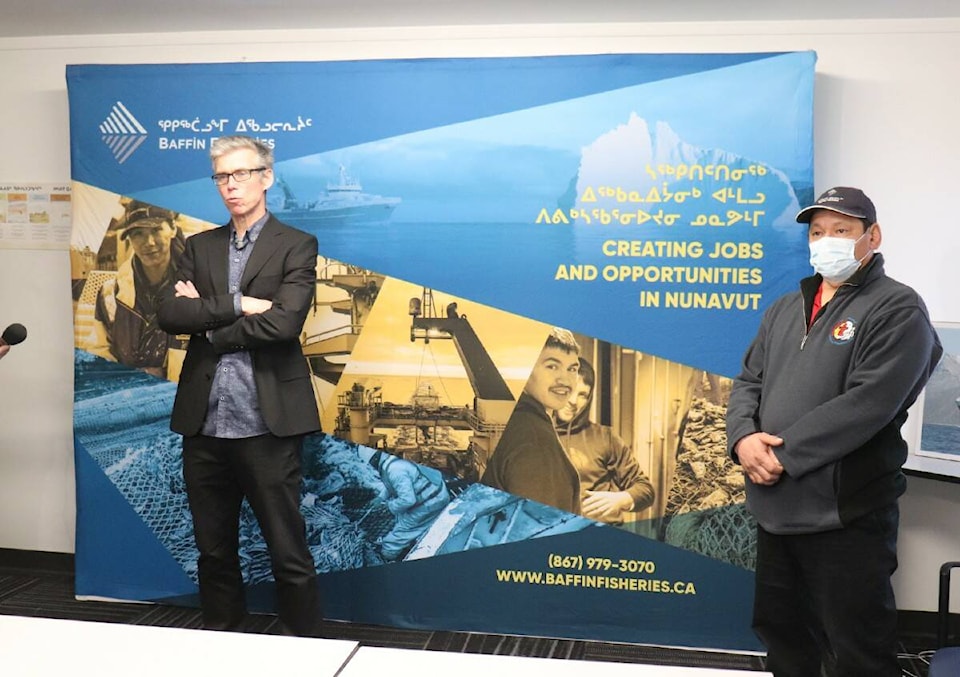On Oct. 29 Baffin Fisheries announced the company has secured funding and signed a contract to build the largest fishing vessel in Canada, which is expected to be delivered in Feb. 2024. The vessel is expected to have a capacity of up to 1,320 tonnes of Greenland turbot or 930 tonnes of cold-water shrimp.
In comparison, the MV Inuksuk I, one of Baffin Fisheries’ larger ships, originally built in 1987 and fully bought out by the company in 2015, is able to hold 650 tonnes of turbot or 440 tonnes of shrimp.
The new vessel will be the fourth in Baffin’s fleet alongside two large factory freezer multi-species trawlers and one factory freezer fixed gear vessel.
“This is a great accomplishment for a 100 per cent Inuit-owned company that’s just 20 years old,” said Baffin Fisheries board member and Hunters and Trappers Association Chair David Alexander in Iqaluit. “The new vessel will allow us to immediately increase benefits to Nunavut communities and improve employment opportunities and working conditions for our Inuit fishermen.”
The new vessel is being designed by the Norwegian company Skipsteknisk A/S, who also designed the MV Inuksuk, and will be constructed by the Turkish Tersan Shipyard, who are known for constructing and designing stern trawlers.
The nearly $72 million acquisition is made possible by incremental financing of up to $60 million from Scotiabank that included direct lending from Export Development Canada (EDC). The Canadian Economic Development Agency (CanNor) is also providing a $3 million repayable contribution toward the ship, which was able to put the company over the top in securing this new ship.
Baffin Fisheries CEO Chris Flanagan stated that between those financiers the company was able to finance the new vessel from within Canada.
The financing from Scotiabank was backed up by five years of financial statements, says Flanagan, with Glenn Grandy, chief financial officer of Baffin Fisheries adding Scotia wouldn’t have given them the money if they weren’t confident that they would make its money back.
“Canadian banks are not known for being familiar with the fishing business and with Nunavut companies for a second thing. We were able to get multiple banks to bid on this because looking into Baffin Fisheries … they felt it was a very strong company,” Flanagan said.
“This incredible new vessel reduces our carbon footprint, provides greater returns to shareholders, and has capacity for expansion, including the ability to harvest new species in the future,” said Flanagan.
One of those new species which could be a potential catch is redfish, which usually reside in mid-depth regions of the ocean. While there’s no quota for redfish at this time, it is expected to be a commercially viable resource in about a decade’s time.
The new ship will be designed with the Arctic in mind, says the CEO.
It will have room for 34 people, however it is expected to be able to function with a crew of 30, with the extra spots being for mentoring and training.
“The offshore fishery in Nunavut is very new, it’s only 20 years old with this company. So Baffin Fisheries needs a way to train young fishermen to work in a commercial operation such as this. With the extra accommodations on the vessel, we will be able to have mentors for new positions,” explained Flanagan, who says there isn’t a long-standing commercial fishing tradition in the territory like that of Newfoundland or other Atlantic provinces.
Alexander explained the mentorship and training ability aligned with the company’s goals to maximize Inuit employment.
More energy efficiency, electronic winches and more storage space are just some of the ways this new vessel will improve upon past ships, says a release by Baffin Fisheries.
Flanagan says they expect a 15 to 20 percent improvement in cash flow once this ship is up and running.
“We are proud to support this investment in Baffin Fisheries,” said Sean Albert, senior vice president of business banking distribution at Scotia Bank, “and (to) support this strong Inuit owned fishing company.”
Baffin Fisheries was incorporated 20 years ago on Nov. 6, 2001, and is owned by five Inuit hunters and trappers associations in the Qikiqtani region. These include Iqaluit, Pangnirtung, Kimmirut, Clyde River and Pond Inlet with offices in Iqaluit, Pangnirtung, Pond Inlet and Paradise, Newfoundland. It holds a 32 per cent minority share in Pangnirtung Fisheries.
While the majority of the catch will end up in Newfoundland due to the lack of deep-sea ports in Nunavut, Baffin Fisheries is expecting to be able to use the newly announced Qikiqtarjuaq deep-sea port once it is finished to drop off smaller amounts of fish.
